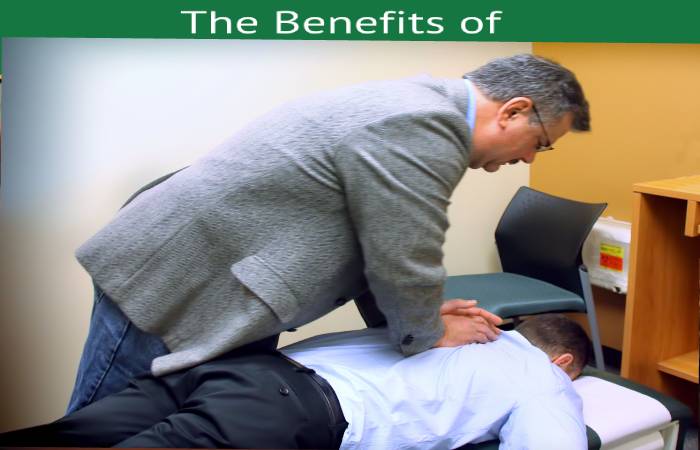Chiropractic Definition
Chiropractic is the health occupation that deals with the diagnosis, care and prevention of alterations of the musculoskeletal system and the effects that these disorders produce on the nervous system and health in general.
The brain communicates with the rest of the body through the nervous system. Nerves are like telephone lines that allow this communication; They are born in the spinal cord and exit through the 24 vertebrae of the spine to all the body’s organs, glands, and tissues.
The stress that we experience, whether physical, chemical or emotional and to which we cannot adapt, causes the muscles to tense up, displace the vertebrae out of place and irritate the nerves that pass through them.
This incorrect position of the vertebra causes pressure and damage to the nerve roots as they exit each vertebra of the spine, known as subluxation. And also, this defined the set of functional, structural, or even pathological changes that compromise the function of the nervous system, be influencing.
Table of Contents
Characteristics of Chiropractic

The techniques used are fundamentally manual, the specific manual vertebral adjustment being a unique characteristic of our profession.
1. Spine and Nervous System
- The brain controls all the body functions through an extensive communication network: the nervous system, which reaches every organ and every cell in your body.
- Every movement you make, like typing on this keyboard, every sensation you perceive, like reading this text, is every vital process that your body performs automatically.
- Such as your heartbeat, breathing or keeping your blood pressure optimal, are made thanks to this fantastic central computer and its extensions.
- And also, it is what allows your body to function harmoniously at all times and maintain its natural state of health.
- These delicate and incredibly complex apparatus protect the bones of the skull and spinal column, the central axis of the locomotor system.
- From there, an infinity of nerve networks branches out that reaches every part of your body so that this innate intelligence can express itself in its entirety and keep you alive and healthy.
2. Vertebral Subluxation
- For this process to develop optimally, the nervous system must be able to function without interference.
- The protective organ of the nervous system, the spinal column, is usually exposed to certain limitations in its functioning.
- And also, it will have negative consequences on the nervous system, which will affect the body.
- The vertebral column makes up of twenty-six mobile segments, in addition to its articulation with the skull, which itself has a certain degree of plasticity, minimal but of great importance.
- This marvel of engineering is a very flexible machine. And also resistant but also very sophisticated, with extremely high precision.
- Due to a series of factors that accumulate throughout life, some segments tend to see their ability to function and move perfectly altered.
- When this happens, a certain degree of interference occurs on the nervous system, which means that its ability to organize the body’s work and maintain an optimal level of health is limited.
- And also, this phenomenon is what we call the vertebral subluxation complex or vertebral subluxation.
3. Specific Vertebral Adjustment
- The chiropractic adjustment repositioned the vertebra that has lost its correct position and mobility. With this, the flow of information between the brain and the rest of the body recovers its normality.
- Speed, force, angle, vector, rotation and intention are fundamental elements when adjusting. The more specific the setting, the better results we will get.
- The specificity is unique to chiropractic and consists of precisely adjusting the segments affected by the vertebral subluxation complex to return the spinal column to a state of functional normality.
- And also eliminate the interferences produced on the nervous system.
- And also, it is precisely this specificity that makes the difference between chiropractic adjustment. Spinal manipulation carried out by other health branches such as osteopathy or physiotherapy.
- The chiropractic adjustment does not hurt, is not invasive and lacks the side effects.
- And also, it is usually associated with even the seemingly milder medications since, far from interfering with the body’s natural functioning, it seeks its restoration.
- Anyone of any age and condition (from newborns to the elderly) can adjust to the wide range of techniques acquired throughout higher university studies.
- At the ARS Chiropractic Center, we will decide the best ones to achieve an optimal result in your particular case.
Benefits of Chiropractic

- Reduces premature ageing;
- Slows cell damage;
- And also improves cell repair and revitalization;
- Balances the neuro-immuno-endocrine axis;
- Increase the speed of healing;
- Strengthens the Immune System;
- Improves physical performance;
- Decreases painful symptoms;
- And also, it prevents illnesses;
- Improves sexual activity in both sexes;
- Improves intellectual performance;
- Increases the feeling of well-being;
- Elevate the mood;
- It increases the ability to concentrate;
- And also improves creative ability.
Chiropractic Training
- The training of a chiropractor in Singapore is equivalent to a bachelor’s degree in Spain. The Chiropractic career lasts six to seven academic years. The number of academic courses varies according to the countries, equivalent to about 5,500 teaching hours.
- At the end of the degree, the title of Doctor of Chiropractic (Doctor of Chiropractic). Or Bachelor of Chiropractic (if the studies carried out in Europe) obtain.
- The training of the Doctor of Chiropractic enables him to practice as a primary care practitioner.
- And also, it can consult or determine if the patient should follow medical care instead of or at the same time as a chiropractor. And, where appropriate, refer him to other doctors.
- The chiropractic profession is prepared to diagnose and care for the vertebral subluxation complex. And also neuro-pathophysiological alterations through specific manual adjustment.
- To ensure the uniformity of teaching and the quality of the education given in all the institutions accredited to teach the Bachelor of Chiropractic, Accrediting Councils creating.
- They supervise the curricula and inspect the universities that teach them.
- In Europe, the European Council for Chiropractic Education establishes the educational standards for the profession.
- Therefore, she is in charge of carrying out this work, standardizing the study plans. Controlling the subjects taught (theoretical and practical).
- And also the number of credits and recognizing the degrees issued by these universities.
Conclusion
A healthcare profession is concerned with diagnosing, treating. And also, preventing disorders of the neuromusculoskeletal system and their effects on general health.
It bases on manual techniques, including joint adjustments and manipulations focusing mainly on subluxations.
Chiropractic deals with the detection, analysis and correction of subluxation chiropractic vertebral subluxation complex. Or through the use of chiropractic procedures based on rational and empirical evidence available today.

